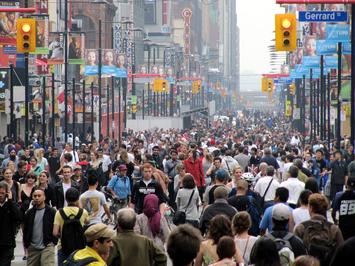
The glory of cities is to serve as places of interaction between people and economies. Yet throughout history—from Roman times to the present—this advantage has also entailed exposure to deadly contagions. As Marc Riedl, a specialist in respiratory disease at UCLA, puts it: “Megacity life is an unprecedented insult to the immune system.” Today’s coronavirus pandemic reflects these patterns, concentrating, at least initially, in densely populated regions, such as Wuhan, Madrid, and around Milan. In the United States, the vast majority of cases to date are occurring in the densest, most globalized regions, such as Seattle, San Francisco, and, in particular, greater New York. Cases have been far less prevalent, so far, in the vast middle of the country—except for New Orleans and Detroit—and in rural areas, where people have less daily contact.
Yet density is not a death sentence. Taiwan and South Korea—which have denser cities—and Singapore, roughly the density of New York City, have largely avoided the worst of the outbreaks. In all three countries, health officials took decisive and early steps to control travel and identify those who might be susceptible to the disease. Some of this was based on experience from earlier contagions, such as SARS, and from a far more disciplined population and more effective, authoritative governance. From the beginning, notes MIT Technology Review, Singapore authorities worked to piece together the complex chain of transmission from one person to another. As of February, anyone entering a government or corporate building in Singapore had to provide contact details. South Korea also began aggressive testing early on and has administered at least a quarter-million tests.
By contrast, the U.S. and Europe have been slower to address the crisis, posing a significant threat to their cities. Europe’s fast-growing infection rate is, to some extent, the product of its weak border controls, one of the EU’s proudest accomplishments. Canada was also slow to act. It did not ban overseas travelers until mid-March; flights from China to Vancouver continued as late as March 15, reportedly without screening or testing.
As a result, we’re seeing in Europe and North America a shutdown of many urban essentials, including in dense and transit-dominated New York. To tell New Yorkers to avoid crowded subways—a legitimate concern—is also to take away one way that dense cities work. Mass-transit ridership, struggling throughout the country, has taken a huge hit during the crisis, leaving systems in perilous financial shape. In New York, despite efforts to keep the subway cars clean, ridership is down as much as 50 percent, as the lockdown has many commuters working from home. The massive transit subsidies in the federal stimulus could end up largely plugging holes from devastated budgets.
The pandemic raises issues that should have been confronted after earlier scares such as SARS, Ebola, and swine flu. Cities, historian William McNeill noted in his revealing Plagues and Peoples, have always struggled from being “unhealthy places.” To avoid the high rates of infectious disease in the tropics, the earliest cities generally were built in the dry areas of Mesopotamia, Egypt, northern India, and China, as well as in the Mediterranean basin. Even so, the great classical cities—Athens, Rome, and Alexandria—all suffered from periodic plagues that, in some cases, wiped out as much as half their population.
Trade, an essential element of cities, often triggered what McNeill described as “fateful encounters” with foreign pestilence. The rat-borne bubonic plague came to Europe on ships from the East, where the disease originated. It affected the cosmopolitan centers of Renaissance Italy—with their often crowded and filthy marketplaces—far more than the rural, backward reaches of Poland or other parts of central Europe. Those who could—like some contemporary wealthy New Yorkers fleeing to country homes—tried to avoid the contagion by holing up in rural redoubts, where the chances of infection, though not negligible, were generally less. Boccaccio’s Decameron relates 100 stories told by a coterie of elite Florentine youths who fled the 1348 outbreak of the Black Death.
Modernity brought its own health crises. Friedrich Engels speaks powerfully in The Condition of the Working Class in England of the squalid conditions endured by Britain’s mid-nineteenth-century urban poor. Mortality rates in London were three times higher than in the surrounding countryside, making the city dependent on constant demographic infusions from the hinterlands and Ireland. The urban proletariat suffered stunted lives, not only in terms of economics but also regarding their physical stature and longevity. Epidemics of infectious diseases such as cholera, typhoid, typhus, smallpox, and tuberculosis were widespread, and crowded conditions, alcoholism, and mass prostitution contributed to a public-health nightmare.
Such maladies also became commonplace in America. Pollution of air and water was rampant—observers speak of the Ohio River in Cincinnati turning red with “rivers of blood” from slaughtered pigs. Residents of industrial cities like Pittsburgh suffered high rates of lung infection. Smog in southern California in the past created an environment so toxic that young children often had to be warned not to play outside.
Read the rest of this piece at City Journal.
Joel Kotkin is the author of the just-released book The Coming of Neo-Feudalism: A Warning to the Global Middle Class. He is the Presidential Fellow in Urban Futures at Chapman University and Executive Director for Urban Reform Institute — formerly the Center for Opportunity Urbanism. Learn more at joelkotkin.com and follow him on Twitter @joelkotkin
Photo credit: Loozrboy via Flickr under CC 2.0 License.












